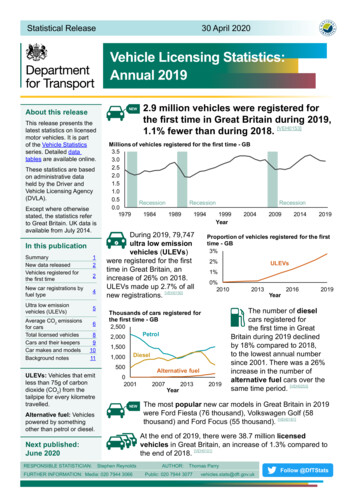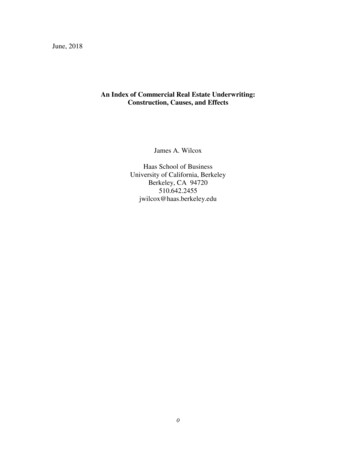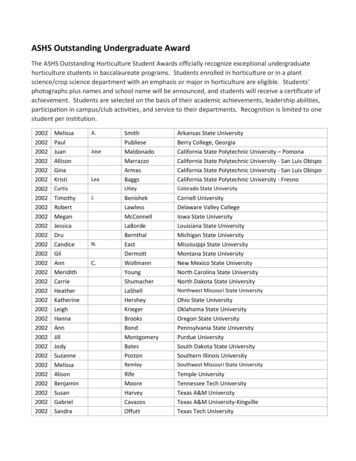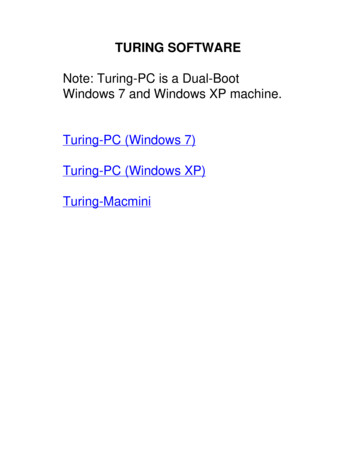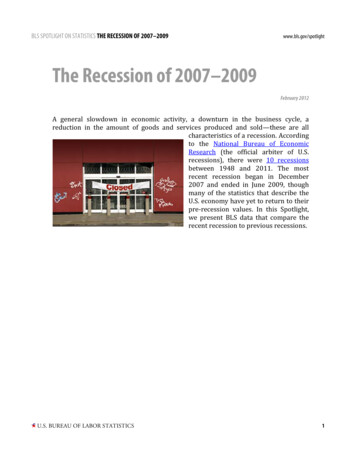
Transcription
BLS SPOTLIGHT ON STATISTICS THE RECESSION OF 2007–2009www.bls.gov/spotlightThe Recession of 2007–2009February 2012A general slowdown in economic activity, a downturn in the business cycle, areduction in the amount of goods and services produced and sold—these are allcharacteristics of a recession. Accordingto the National Bureau of EconomicResearch (the official arbiter of U.S.recessions), there were 10 recessionsbetween 1948 and 2011. The mostrecent recession began in December2007 and ended in June 2009, thoughmany of the statistics that describe theU.S. economy have yet to return to theirpre-recession values. In this Spotlight,we present BLS data that compare therecent recession to previous recessions.U.S. BUREAU OF LABOR STATISTICS1
BLS SPOTLIGHT ON STATISTICS THE RECESSION OF 2007–2009www.bls.gov/spotlightUnemploymentOne of the most widely recognized indicators of a recession is higher unemploymentrates. In December 2007, the national unemployment rate was 5.0 percent, and it hadbeen at or below that rate for the previous 30 months. At the end of the recession, inJune 2009, it was 9.5 percent. In the months after the recession, the unemploymentrate peaked at 10.0 percent (in October 2009). Before this, the most recent monthswith unemployment rates over 10.0 percent were September 1982 through June1983, during which time the unemployment rate peaked at 10.8 percent.Compared with previous recessions, the higher proportion of long-term unemployed(those unemployed for 27 weeks or longer) in the recent recession and its postrecession period is notable.NOTE: People are classified as unemployed if they do not have a job, have actively looked for work in the prior 4 weeks, and arecurrently available for work. The unemployment rate is the number of unemployed persons as a percent of the labor force. (The laborforce is the total number of employed and unemployed persons.) The long-term unemployment rate is the number of personsunemployed for 27 weeks or longer as a percent of the labor force. To learn more, see How the Government MeasuresUnemployment, http://www.bls.gov/cps/cps htgm.htm.Source: Current Population SurveyU.S. BUREAU OF LABOR STATISTICS2
BLS SPOTLIGHT ON STATISTICS THE RECESSION OF 2007–2009www.bls.gov/spotlightUnemployment DemographicsUnemployment rates of Blacks or African Americans and Hispanics or Latinoshistorically have been higher than the rate for Whites.In the months during and afterthe recent recession, unemployment rates for Blacks or African Americans andHispanics or Latinos remained below the peaks they reached in 1982 and 1983, whilethe unemployment rate of Whites was very comparable to that of 1983.Source: Current Population SurveyU.S. BUREAU OF LABOR STATISTICS3
BLS SPOTLIGHT ON STATISTICS THE RECESSION OF 2007–2009www.bls.gov/spotlightFor many years, men's unemployment rates were generally lower than women's bothduring and between recessions. However, since the early 1980s, men'sunemployment rates have been higher than women's during or immediately afterrecessions, and the rates for men and women have been quite similar in other periods.Higher unemployment among men was especially notable during and immediatelyafter the recent recession.Source: Current Population SurveyU.S. BUREAU OF LABOR STATISTICS4
BLS SPOTLIGHT ON STATISTICS THE RECESSION OF 2007–2009www.bls.gov/spotlightUnemployment by StateUnemployment rates vary from one place to another. In the months after the end ofthe recent recession, North Dakota, Nebraska, and South Dakota had the lowestmonthly unemployment rates (5.2 percent or lower) among the 50 states. Nevada,California, and Michigan had some of the highest jobless rates (above 10.0 percent).(This is an interactive chart on the BLS Spotlight HTML page.)Source: Local Area Unemployment StatisticsU.S. BUREAU OF LABOR STATISTICS5
BLS SPOTLIGHT ON STATISTICS THE RECESSION OF 2007–2009www.bls.gov/spotlightUnemployment Rates Around the WorldCompared with the unemployment rates of other industrialized countries, the U.S.unemployment rate was higher than a few and lower than most other countriesbefore the start of the most recent recession. By the end of the recent recession, theU.S. unemployment rate was higher than most other industrialized countries, and itremained so in the months following the recession.(This is an interactive chart on the BLS Spotlight HTML page.)Source: International Labor ComparisonsU.S. BUREAU OF LABOR STATISTICS6
BLS SPOTLIGHT ON STATISTICS THE RECESSION OF 2007–2009www.bls.gov/spotlightEmployment Fell More Rapidly Than During Prior RecessionsThe employment decline experienced during the December 2007–June 2009recession was greater than that of any recession of recent decades. Forty-sevenmonths after the start of the recession that began in November 1973, for example,employment was more than 7 percent higher than it had been when the recessionstarted. In contrast, 47 months after the start of the most recent recession (November2011), employment was still over 4 percent lower than when the recession began.NOTE: In this chart, employment levels for recent recessions are set equal to 100 at the start of each recession. The solid boxes onthe chart indicate the beginning of recessions. The empty box markers on each line indicate ends of recessions. On the line for therecession that began in January 1980, a second solid box indicates the start of another recession that began in July 1981.U.S. BUREAU OF LABOR STATISTICS7
BLS SPOTLIGHT ON STATISTICS THE RECESSION OF 2007–2009www.bls.gov/spotlightSource: Current Employment StatisticsU.S. BUREAU OF LABOR STATISTICS8
BLS SPOTLIGHT ON STATISTICS THE RECESSION OF 2007–2009www.bls.gov/spotlightEmployment of Young AdultsEmployment of young adults declined—as it did in all other groups—during therecent recession. Employment of young men generally increased during much of2006. After a dip in late 2006, employment of young men trended upward and thenremained fairly stable until late fall of 2008, well into the recent recession. After apeak of about 88 percent in fall 2007, young men's employment declined from late fall2008 until June 2009, when it was just over 82 percent. As a share of population,employment of young women tended to be about 8 to 9 percentage points below thatof young men. After reaching a peak of over 79 percent in late 2007, employment ofyoung women remained fairly stable through about December 2008, and then, similarto that of men, it declined until it was about 73 percent in June 2009.NOTE: Young adults are those who were born in the years 1980 and 1981 and thus were ages 25 to 26 by December of 2006 andwere ages 28 to 29 by December 2009.Source: National Longitudinal SurveysU.S. BUREAU OF LABOR STATISTICS9
BLS SPOTLIGHT ON STATISTICS THE RECESSION OF 2007–2009www.bls.gov/spotlightDifferent Effects on Different IndustriesGenerally, goods-producing industries experience the largest declines in employmentduring recessions. The 2007–2009 recession was typical in this regard, withconstruction and manufacturing both experiencing their largest percentage declinesin employment of the post-WWII era, 13.7 and 10.0 percent, respectively (percentagesexpressed in annual rates, as measured from the first month to the last month of therecession).Few industries attracted as much attention during the recent recession as financialactivities, which experienced a 3.9-percent reduction in employment. Before 2007, theonly recession since 1939 to see job losses in financial activities was that of 1990–1991.Employment increased in education and health services during the recent recession.In fact, employment has increased in education and health services for more than 30years, regardless of the business cycle. Employment in education and health serviceshas decreased in only 1 of the 12 recessions that have occurred since 1945.NOTE: Because recessions vary in length, the percentage changes shown in the chart are each calculated across a different numberof months for each recession and then converted to percentages expressed on an annualized basis.U.S. BUREAU OF LABOR STATISTICS10
BLS SPOTLIGHT ON STATISTICS THE RECESSION OF 2007–2009www.bls.gov/spotlightSource: Current Employment StatisticsU.S. BUREAU OF LABOR STATISTICS11
BLS SPOTLIGHT ON STATISTICS THE RECESSION OF 2007–2009www.bls.gov/spotlightEstablishment Births and DeathsIn lay terms, an "establishment birth" is the opening of a new business; an"establishment death" occurs when a business closes. During the most recentrecession, for the 3 months ended in March 2009, the private sector experienced atotal of 235,000 establishment deaths and 172,000 establishment births (a low forthis data series, which began in 1992)—resulting in a net decrease of 63,000establishments (the biggest decrease since the data series began).NOTE: Establishment births are counted when an establishment has zero employment in the third month four quarters in a row andthen has employment above zero in the third month of a quarter (excluding seasonal businesses that reappear with positiveemployment within the last five quarters). Establishment deaths are units with no employment or zero employment reported in thethird month of four consecutive quarters following the last quarter with positive employment. Births and deaths are subsets ofopenings and closings, which excludes seasonal re-openings and shutdowns. The gap between births and deaths data, as shownhere, is one measure of net establishment change and differs from the gap between the number of opening establishments and thenumber of closing establishments.Source: Business Employment DynamicsU.S. BUREAU OF LABOR STATISTICS12
BLS SPOTLIGHT ON STATISTICS THE RECESSION OF 2007–2009www.bls.gov/spotlightJob Openings and EmploymentThe number of job openings, or unfilled jobs, is an important measure of the unmetdemand for labor. In the months before the start of the recent recession, the numberof job openings, which reached a pre-recession peak of 4.8 million in March 2007,began to decline even while nonfarm employment continued to increase to a peak of138 million in January 2008 (the month after the start of the recession). During therecession, the number of job openings decreased 44 percent while employmentdeclined 5 percent over that same period.A month after the official end of the most recent recession, in July 2009, the number ofjob openings declined to a series low of 2.1 million. Since then, the number of jobopenings has trended upwards and it has been over 3.0 million each month from Mayto October 2011. Employment reached its recent low of 129 million in February 2010and has since increased to 132 million.Source: Job Openings and Labor Turnover Survey andCurrent Employment StatisticsU.S. BUREAU OF LABOR STATISTICS13
BLS SPOTLIGHT ON STATISTICS THE RECESSION OF 2007–2009www.bls.gov/spotlightMass LayoffsA mass layoff occurs when at least 50 initial claims for unemployment insurance arefiled against an establishment during a consecutive 5-week period. During the mostrecent recession, employers took 3,059 mass layoff actions in February 2009involving 326,392 workers, both of which are highs in their respective data series(which both began in 1995).Source: Mass Layoff StatisticsU.S. BUREAU OF LABOR STATISTICS14
BLS SPOTLIGHT ON STATISTICS THE RECESSION OF 2007–2009www.bls.gov/spotlightConsumer SpendingIn constant 2010 dollars, average expenditures per consumer unit (in ordinarylanguage: "households") were 46,119 in 1984, and they peaked at 52,349 in 2006.Since the recent recession started, average expenditures (in constant 2010 dollars)have dropped from 52,203 in 2007 to 48,109 in 2010. During this period, spendingdecreased in every major category except healthcare.NOTE: From 1984 to 2010, average annual expenditures of all consumer units rose from 21,975 to 48,109. Much of this increasewas due to the effects of inflation: a dollar in 1984 was worth more than a dollar in 2010. The Consumer Price Index is used to adjustthese "nominal dollar" values into "constant dollar" values, such that a dollar in any year is worth the same as a dollar in any otheryear.Source: Consumer Expenditure SurveyU.S. BUREAU OF LABOR STATISTICS15
BLS SPOTLIGHT ON STATISTICS THE RECESSION OF tivity is more likely to fall during a recession than it is during an economicexpansion. In 3 of the last 11 recessions, output fell more than labor input in thenonfarm business sector, leading to a fall in labor productivity. Productivity may alsogrow in recessions, when labor input falls more than output does. This occurred in 8of the last 11 recessions, including the most recent recession.NOTE: Productivity is measured by comparing outputs (the goods and services produced) to inputs (the labor and capital used inproduction.) Labor productivity is the ratio of the output of goods and services to the labor hours devoted to the production of thatoutput.Source: Labor Productivity and CostsU.S. BUREAU OF LABOR STATISTICS16
BLS SPOTLIGHT ON STATISTICS THE RECESSION OF 2007–2009www.bls.gov/spotlightEmployment CostsThe Employment Cost Index—which measures the change in the cost of labor, freefrom the influence of employment shifts among occupations and industries—has beencalled a "lagging indicator." Reductions in the growth of wages and salaries typicallybegin during recessions and continue well into the post-recession recovery, before thewages and salaries growth rate begins to increase again. During the recession of2007–2009, the increases in the wages and salaries of private industry employeesslowed to 1.3 percent in December 2009. This was far below the 3.6 percent increasein March 2007, after the recovery from the 2001 recession.Source: Employment Cost TrendsU.S. BUREAU OF LABOR STATISTICS17
BLS SPOTLIGHT ON STATISTICS THE RECESSION OF 2007–2009www.bls.gov/spotlightThe April issue of the Monthly Labor Review contains articles on the 2007–2009recession. Also see the archived articles in the "Recession" index.Note: Data in text, charts and tables are the latest available at the time of publication.Internet links may lead to more recent data.General InformationFor more information, please call (202) 691-5200.Media ContactThe news media can contact the BLS Press Officer at(202) 691-5902.U.S. BUREAU OF LABOR STATISTICS18
during recessions. The 2007-2009 recession was typical in this regard, with construction and manufacturing both experiencing their largest percentage declines in employment of the post-WWII era, 13.7 and 10.0 percent, respectively (percentages expressed in annual rates, as measured from the first month to the last month of the recession).



